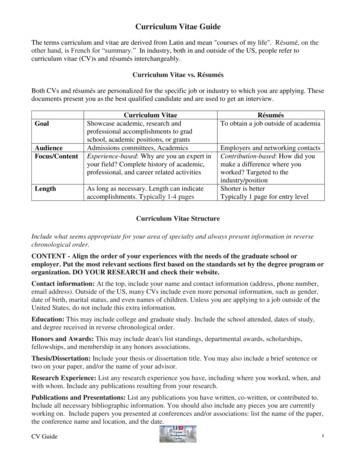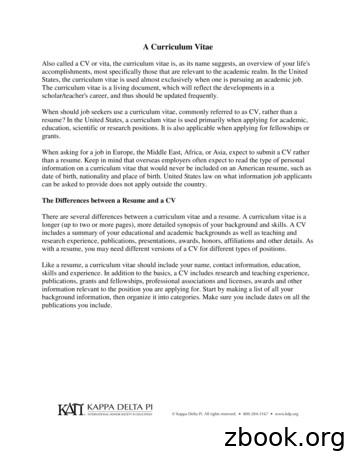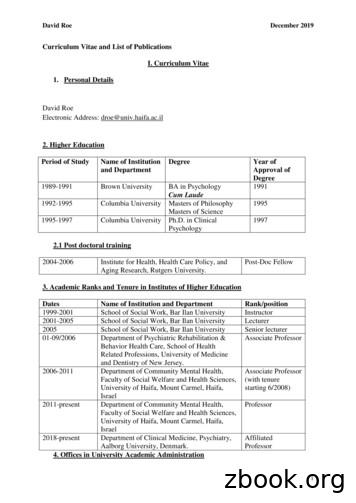CURRICULUM VITAE (CV) GUIDE - Career.ufl.edu
CURRICULUM VITAE (CV) GUIDEcur ric u lum vi tae: Latin, course of (one’s) lifeA curriculum vitae is your first point of contact between you and your future colleagues. The role of a CV is tograb the interest of the reader and encourage him/her to look over your other application materials. For thisreason, it is important to think about how you describe and format your experiences. What will your audiencebe looking for? What do you have that other applicants may not? Your job is to make it easy for your reader tofind the strengths and achievements that you can bring to the position.Comparing the Curriculum Vitae and Resume:A curriculum vitae and a resume are similar in that both highlight one’s education and relevant experience.However, a CV tends to be longer and is used more widely when candidates have published works like scientificevidence or journals. Common for graduate students, a CV tends to include any research experience, teachingexperience, and publications. CVs are more comprehensive as they are used when applying to positions wherespecific field knowledge or expertise is required. Like a resume, there is no one correct format for a CV- the keyis formatting and organization!Curriculum VitaeGoal: Obtain an academic position, research position,or grantAudience: Fellow academic/researcher of similar fieldStructure: Text-heavyLength: (Flexible) as long as necessary-Doctoral CVs typically 3-4 pages-Master’s CVs typically 1-3 pagesContent: Complete history of academic pursuits(including teaching, research, awards, and service)Tailored to highlight ability to conduct research/teachOR tailored to highlight ability to fit with specificjob/fieldResumeGoal: Obtain a nonacademic jobAudience: Potential nonacademic employersStructure: Minimal text, concise, achievementoriented bullet pointsLength: Typically 1 page; limited to 2 pagemaximumContent: Summary of most relevant skills andexperiences tailored to ability to fit with specificjob/companyFORMATTINGTypically, a CV should begin with contact information and education. Sections that include items with variousdates (such as education, research experience, service work, etc.) should be listed in reverse chronologicalorder. Also, don’t forget page numbers!Personal InformationThe personal information section of your CV can appear as the header. Be sure to include: your name, homeaddress, phone number, and email. Some students will include their office/department contact info. Do not1
include: date or place of birth, marital status, gender, religion, social security number, etc. (These should neverbe included on your CV or resume).EducationYour education section should include the name of the colleges/universities attended, the location (city, state,and country if outside of the United States) of each facility, the type of degree earned along with the field ofstudy, and the graduation date.General Formatting:Degree, Discipline AreaGraduation Date (Month Year)University Name, LocationDissertation/Thesis (Optional): Title or TopicCertifications/Awards (Can be included here or later in CV)Beyond the education and personal information sections, CV formatting varies widely. Below are somesuggested categories to include on your CV:Academic ServiceAdministrative ExperienceArticlesAwardsCertificatesCommittee LeadershipCommunity ServiceConference LeadershipConference PresentationsConferences AttendedDissertations/ThesisDepartmental ServiceEducation InterestsEducational OverviewEndorsementsExhibitionsFellowshipsGraduate PracticaGrant Writing ExperienceGrant Funding ReceivedInternational StudyJournal ReviewsLanguagesLeadershipLicensureMaster’s ProjectMonographsPanels OrganizedPanels Served OnPresentationsProfessional AssociationsProfessional CertificationsProfessional ExperiencePublicationsRelevant CoursesRelated EmploymentResearch FieldsResearch InterestsScholarly PresentationsScholarly WorksScholarshipsSkills (Languages)Study AbroadTeaching Assistantships(differentiate from Instructor ofRecord)Teaching InterestsTeaching OverviewTeaching SummaryTechnical SkillsThesisTravel AbroadUniversity InvolvementWorkshopsWhen choosing which categories to include on your resume, think about which will highlight your mostprestigious strengths and achievements in the position/field you are applying for. You may also reformat thecategories so that your strongest points appear earlier in your CV.2
General Formatting for Experience Sections:Your TitleDatesCompany/Organization, City, State/Country Begin description with past tense action verb Describe tasks and responsibilities, quantifying wherever possible Use keywords where its appropriate to demonstrate knowledge of the field You can also have longer, action oriented descriptions instead of bullet points on a CV. Theyshould be easy to read and concise.General Formatting for Awards and Honors: Include: Funding Agency, Title of Award, Date Receive, Amount (optional) Description should demonstrate how you were recognized by your department/professionalorganizationGeneral Formatting for Publications and Presentations:Publication/Presentation Use citation structure that is appropriate for your discipline If multiple authors/presenters, bold your name when listing all namesFinal Points on Formatting:Be consistent in your formatting. Use formatting (bold, italics, underlines) to separate sections and help readers navigate the page. Some opportunities prefer a traditional CV (very basic formatting, essentially lists, no descriptions). After the first page, begin page numbering (2,3,4,5 .) 0.5 Margin Minimum; 11pt Font Size Minimum Use Standard Fonts (i.e. Arial, Times New Roman) When applying to professional schools/programs, it is important to check their website for required CVformatting (CVs vary per school, program, and even field of study) Tell what you did, how you did it, and what the result was. If altering your CV into a resume for a non-academic job, focus more on the processes than the content of thework, and use bullet points.WRITING BULLET POINTS OR DESCRIPTIONSTransferable skills are the tasks you know how to do regardless of where they take place. They describe yourfunctional skills. Action verbs are strong active words which help you clarify your activities in a meaningful andrelevant way. Emphasize results to show accomplishments. - Action verb Transferable skills/Task Result.Example: Demonstrated leadership by conducting individual training for new employees who all moved intomanagement positions3
REFERENCESUnlike a resume, a CV includes references. If possible, provide 3-6 references (with at least name, address, andcontact information) of individuals who can comment positively on your capabilities. Remember: Always askyour references if you can include them on any documents (not just your CV), and let them know if they may becontacted.Example:Dr. Alice AlligatorResearch AdvisorDepartment of ChemistryUniversity of FloridaGainesville, FL 32611(123) 123-4567For Additional Resources (including CV examples for various industries) check outhttps://chroniclevitae.com/news, search “CV” and select “Articles”CURRICULUM VITAE EXAMPLEAlbert Gator101 Main Street, Gainesville, FL 32611 (123) 456-7890 albertgator@email.comEDUCATIONPhD, Discipline AreaCollege of Gator Professions, University of Florida Dissertation: title or topicMonth YearMPH (or other Master’s degree), Discipline AreaSchool if appropriate, University Name Master's Thesis: title or topic Certifications/Award (Can be included here or in later section)Month YearBA (or other Bachelor’s degree), Discipline AreaUniversity NameMonth YearSUMMARY OF RESEARCH SKILLS (optional)Examples: Project management * grant and proposal writing * research methodology & design * Institutional Review Boardclearance * participant recruitment * data collection * data management * statistical analysis (SPSS, Mplus, ATLAS.ti) * onlinesurvey design and programming (Qualtrics) * oral presentations * cost effectiveness analysisRESEARCH INTERESTS (optional)Examples: Obesity * obesity related co-morbidities * physical activity * nutrition * social support * technology-based healthinterventions * structural equation modeling * health behavior theory * health communications * research dissemination &translationAWARDS AND HONORS4
Things to Include: Funding Agency (agency or departmental/university award), Type or Title of Award, 20XX-20XX,amount (optional)This section demonstrates how you are recognized by your department or professional organizationsAward amounts may demonstrate your ability to win grants or manage fundsPROFESSIONAL/RESEARCH EXPERIENCEYour TitleCompany/Organization, City, State or Country Start each bullet with a skills-based action verb Be sure to quantify your accomplishments, not just describe tasks and responsibilities Use keywords that demonstrate your knowledge of the field and technologies as appropriate More details More detailsDissertation ResearchUF Blue and Orange Department, Gainesville, FL Managed a team of 10 people to ensure the timely findings of current gator literature Retrieved the impact factors of each studies reviewed to determine its extent of influence More details More detailsTEACHING & MENTORING EXPERIENCEYour TitleCourse Name Begin each bullet with a skills-based action verb Month Year - PresentMonth Year - PresentSemester Year & Semester YearBe sure to quantify your accomplishments, not just describe tasks and responsibilitiesUse keywords that demonstrate your knowledge of the field and technologies as appropriateMore detailsUndergraduate Teaching AssistantSpring 2017UFL1234: How to be a Gator Scheduled and oversaw regular meetings and managed student activities including class objectives and lesson plans Provided recommendations and career advice as needed during TA office hoursPUBLICATIONS AND PRESENTATIONSPublications Use the citation structure appropriate for your discipline/area of study Bold your name within the list of authorsSelected Presentations Use the citation structure appropriate for your discipline. Bold your name within the list of authors if appropriatePROFESSIONAL AFFILIATIONSInclude memberships and leadership rolesACADEMIC SERVICE AND OTHER ACTIVITIESThis section may be set up the same as the experience sections above or a simple list of organizations, roles/titles, and dates.5
Comparing the Curriculum Vitae and Resume: A curriculum vitae and a resume are similar in that both highlight one’s education and relevant experience. However, a CV tends to be longer and is used more widely when candidates have published works like scientific evidence or journals.
Curriculum Vitae Guide The terms curriculum and vitae are derived from Latin and mean "courses of my life". Résumé, on the other hand, is French for “summary.” In industry, both in and outside of the US, people refer to curriculum vitae (CV)s and résumés interchangeably. Curriculum Vitae vs. Résumés
CV curriculum vitae CV v. resume – Length – Scholarly/scientific. Curriculum Vitae CV curriculum vitae CV v. resume – Length – Scholarly/scientific – Detailed. Curriculum Vitae (CV) Name, title, curren
A Curriculum Vitae Also called a CV or vita, the curriculum vitae is, as its name suggests, an overview of your life's accomplishments, most specifically those that are relevant to the academic realm. In the United States, the curriculum vitae is used
Career Clusters . Career Clusters are broad occupational groupings based on a set of common knowledge and skills required for a specific career. Career Clusters provide opportunities for all students regardless of their career goals and interests. Career Pathways . Career Pathways are a sub-grouping of occupations and career specialties used .
3.0 TYPES OF CURRICULUM There are many types of curriculum design, but here we will discuss only the few. Types or patterns are being followed in educational institutions. 1. Subject Centred curriculum 2. Teacher centred curriculum 3. Learner centred curriculum 4. Activity/Experience curriculum 5. Integrated curriculum 6. Core curriculum 7.
1 Curriculum Vitae and List of Publications I. Curriculum Vitae 1. Personal Details David Roe Electronic Address: droe@univ.haifa.ac.il 2. Higher Education Year of Approval of Degree Name of Institution Degree and Department Period of Study BA in Psychology 1991 Cum Laude 1989-1991 Brown University Masters of Philosophy 1995 Masters of Science
Career clusters are one way to group career paths. Careers with common features are in the same cluster. The 16 Career Clusters outlined in this Resource Guide can be used during career exploration as a way to find your best career match. Review the circular graphic on page 14 to see how the career fields, career clusters & pathways fit together.
vi 6 4kÚezpÜhªÔ ã 15 7 4kÚeypã[njªÔ ã 16 h p 8Ù it hcÕ ã hÔ Ý 1 zià[ yj³Ý 17 2 zetãp[njÝ 17 3 4 Üyh³Ý p[njÝ 18























